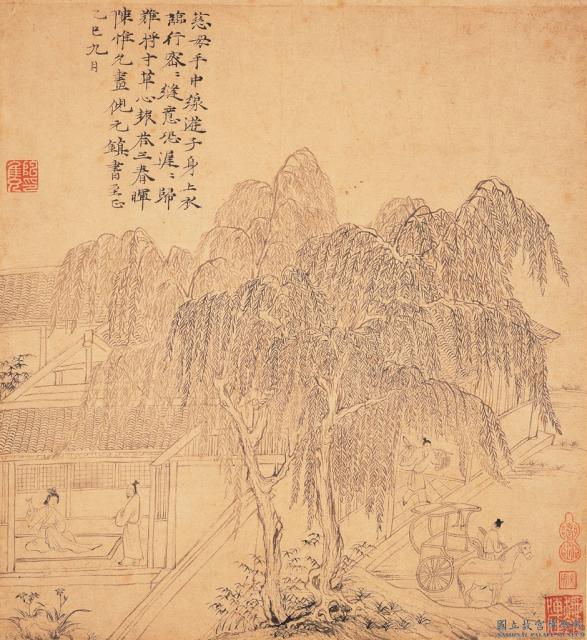集古圖繪 冊 明陳惟允詩意圖
推薦分享
資源連結
連結到原始資料 (您即將開啟新視窗離開本站)後設資料
- 資料識別:
- 故畫001258N000000006
- 資料類型:
- 類型:繪畫
- 型式:靜態圖像
- 著作者:
- 陳惟允
- 主題與關鍵字:
- 仕女 侍從(侍女、童僕) 百姓 楊柳 竹 房舍 獸力車
- 出版者:
- 數位化執行單位:國立故宮博物院
- 日期:
- 元順帝至正二十五年(1365)
- 格式:
- 本幅 36.6x33.9公分、全幅 50.2x77.3公分
- 關聯:
- 石渠寶笈初編(重華宮),上冊,頁727&*故宮書畫錄(卷六),第四冊,頁250&*陳汝言(活動於西元十四世紀中葉)字惟允,號秋水,臨江(今江西靖江)人,寓吳縣(今江蘇蘇州)。工詩畫。畫山水宗趙孟頫,清潤可愛,兼工人物。 水墨畫唐孟郊詩意,畫筆古雅清逸,無塵俗氣,全學馬和之;倪瓚書原詩,筆意硬拙挺捷,款題至正乙巳(一三六五),時倪瓚六十五歲。書畫均佳,可謂珠聯璧合。 本幅選自「集古圖繪」冊。&*Ch'en Ju-yen, a native of Kiangsi province who resided in Soochow, was gifted at poetry and painting. In landscape painting, he followed after Chao Meng-fu for a pure and understated style. He also did figure painting. This monochrome ink painting was inspired by the T'ang poetry of Meng Chiao. The brushwork is archaic and untrammeled, untainted by worldly cares. It is completely in the style of Ma Ho-chih. Ni Tsan inscribed the original T'ang poem on this work, and his brushwork is taut and intentionally awkward. Ni's inscription is dated to 1365, when he was 64. Both painting and calligraphy form an ideal complement. This is from the album Collection of Ancient Paintings. &* 陳汝言(約活動於十四世紀中葉),字惟允,號秋水,臨江(江西靖江)人,寓蘇州。汝秩之弟,與兄齊名,有大髯小髯之稱。工詩畫,倜儻有謀略。善山水,兼工人物。 柳陰下,僕役忙著搬運行囊至馬車。屋內,一人行將遠遊,其母坐榻上趕縫衣裳。陳氏以追法宋馬和之的風格,描繪孟郊的「遊子吟」,極古雅清逸,與倪瓚的題詩,可謂珠聯璧合。倪瓚之題,年款為至正乙巳(西元一三六五年)九月,本幅當亦畫於此頃。 &* Ch’en Ju-yen (style name Wei Yün, sobriquet Ch’iu Shui) was originally from Lin-chiang (present day Ching-chiang, Kiangsi) but he resided in Soochow. He was the younger brother of Ch’en Ju-tzu, and his fame equals that of his elder brother. Together, they have been nicknamed “big beard” and “small beard.” Ch’en Ju-yen was resourceful and free of manner, and was well-known as both a painter and poet. He specialized in landscapes and figures. In the shade of a willow tree, a servant transports baggage to a carriage. Indoors, a man hurriedly prepares for a long journey, his mother sits on the couch rushing to finish sewing his clothes. Ch’en uses the manner of Ma Ho-chih, a Sung dynasty painter, to illustrate Meng Chiao’s poem “A Wanderer’s Chant.” A sense of archaism pervades the scene. The painting is inscribed by the famous painter Ni Tsan, and the inscription is dated the ninth month of 1365, during the Yüan dynasty. It is said that the painting and the poem are perfectly suited to each other. &*1.蔣復璁,〈倪瓚書遊子吟題陳惟允詩意圖〉,收入國立故宮博物院編,《元四大家》(臺北:國立故宮博物院,1975年初版,1976年二版,1984年三版),頁63。 2.馬孟晶,〈陳惟允詩意圖〉,收入劉芳如、張華芝主編,《群芳譜 — 女性的形象與才藝》(臺北:國立故宮博物院,2003年初版一刷),頁143。 3.林柏亭、張華芝,〈明陳汝言畫唐人詩意〉,收入林柏亭、張華芝編,《畫馬名品特展圖錄》(臺北:國立故宮博物院,1990年元月初版),頁94-95。
- 管理權:
- 國立故宮博物院
授權聯絡窗口
- 國立故宮博物院圖像授權、出版授權、影音資料授權-申請流程說明
http://www.npm.gov.tw/zh-TW/Article.aspx?sNo=03003061






